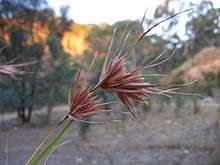Themeda triandra
Themeda triandra is a perennial tussock-forming[2] grass widespread in Africa, Australia, Asia and the Pacific. In Australia it is commonly known as kangaroo grass and in East Africa and South Africa it is known as red grass and red oat grass or as rooigras in Afrikaans.
| Themeda triandra | |
|---|---|
 | |
| Scientific classification | |
| Kingdom: | Plantae |
| Clade: | Tracheophytes |
| Clade: | Angiosperms |
| Clade: | Monocots |
| Clade: | Commelinids |
| Order: | Poales |
| Family: | Poaceae |
| Subfamily: | Panicoideae |
| Genus: | Themeda |
| Species: | T. triandra |
| Binomial name | |
| Themeda triandra | |
| Synonyms[1] | |
|
List
| |
Description
Themeda triandra is a grass which grows in dense tufts up to 1.5 metres (4 ft 11 in) tall and 0.5 metres (1 ft 8 in) wide. It flowers in summer, producing large red-brown spikelets on branched stems.[3] The leaves are 10–30 centimetres (3.9–11.8 in) in length and 1–8 millimetres (0.039–0.315 in) wide[4] but can exceed 10–50 centimetres (3.9–19.7 in) long and 2–5 millimetres (0.079–0.197 in) wide.[3] Its inflorescence is compounded, fasciculated, is 10–30 centimetres (3.9–11.8 in) long and composed of a single raceme. It pedicels are oblong and are 0.5 mm long while its lemma is 25–70 millimetres (0.98–2.76 in) long and is both apical and geniculate. The column of lemma's awn is hispidulous and twisted.[4]
Taxonomy and naming
Themeda triandra was first formally described in 1775 by Peter Forsskål who published the description in Flora Aegyptiaco-Arabica.[5] There are many synonyms of this species.[6] The specific epithet (triandra) is the feminine of the Botanical Latin adjective triandrus, meaning 'with three stamens',[7] based on the Greek-derived combining forms tri-, three, and -andrus, male.[8]
Distribution and habitat
Themeda triandra is found across Asia, Africa, Australia, and the Pacific. In Australia, it is found in all of the states and territories.[3] It grows predominantly in grassland and open woodland communities. It is a significant species in temperate grasslands in Australia, a habitat considered to be endangered or threatened in various parts of the country.[3] It does not do well under heavy grazing pressure, but benefits from occasional fire.[9]
Uses
The young growth is palatable to stock.[10][11] T. triandra seed has been used as a famine food in Africa.[12] It also serves as a food source for several avian species, including the long-tailed widowbird. It is also occasionally used as an ornamental plant.[3]
Gallery
 Flowering spikelet, South Africa
Flowering spikelet, South Africa_(13912868212).jpg) Dry spikelets, South Africa
Dry spikelets, South Africa.jpg) Single seed
Single seed Cultivated in a botanical garden
Cultivated in a botanical garden
References
- "Themeda triandra'". Australian Plant Census. Retrieved 2 July 2019.
- Florabank, retrieved 2 May 2018
- Liles, Jennifer. "Themeda triandra". Australian National Botanic Garden. Retrieved 2 May 2018.
- W.D. Clayton; M. Vorontsova; K.T. Harman; H. Williamson. "Themeda triandra". The Board of Trustees, Royal Botanic Gardens. Kew: GrassBase. Retrieved 2 May 2018.
- "Themeda triandra". APNI. Retrieved 4 November 2017.
- "Themeda triandra". World Checklist of Selected Plant Families (WCSP). Royal Botanic Gardens, Kew.
- Stearn, W.T. (2004). Botanical Latin (4th (p/b) ed.). Portland, Oregon: Timber Press. ISBN 978-0-7153-1643-6.CS1 maint: ref=harv (link) p. 516.
- Stearn (2004), p. 368.
- "Themeda triandra (Kangaroo grass)". New South Wales Government Department of Primary Industries. Retrieved 19 January 2020.
- Burbidge, N. T. Australian Grasses. Angus and Robertson Publishers. 1966.
- "Animal Feed Resources Information System". FAO.org.
- National Research Council (1996-02-14). "Wild Grains". Lost Crops of Africa: Volume I: Grains. Lost Crops of Africa. 1. National Academies Press. p. 271. ISBN 978-0-309-04990-0. Retrieved 2008-07-18.
External links
| Wikimedia Commons has media related to Themeda triandra. |